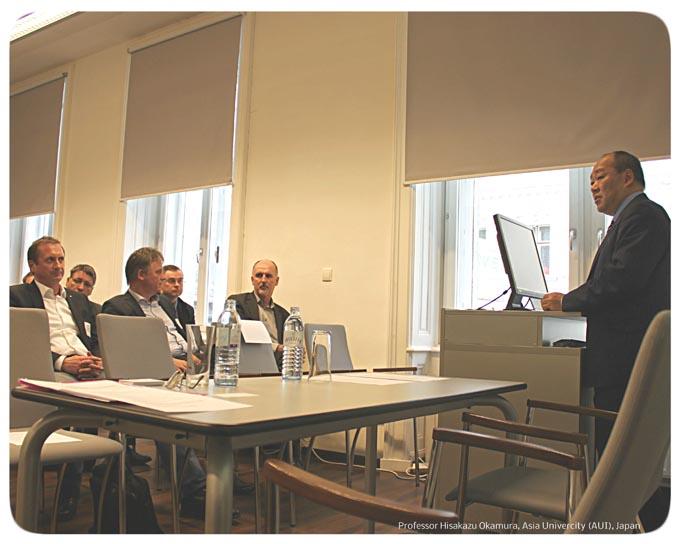The International Workshop "Smart Cities in practice: Implementing Smart Cities and Towns in Central Europe”, February 12, 2016, Vienna

The event started with the lecture by Professor Hisakazu Okamura from Asia University (AUI), Tokyo, Japan. Professor Okamura delivered about experiences in the implementation of Smart Cities concept in Japan and other countries of the world.
The lecture started with the broad view of the topic meaning in different cultures and countries illustrated by rich practical examples from real life. In particular there were some interesting observations as follows:
In different countries, the term “Smart city” is understood in different ways. For example in the USA, the term was associated with the — High Tech Super City. In Japan, this term was associated with the High Tech IT supported city. The interesting thing is that now in Japan the current notion is not about Smart cities but Regional creation and City recreation. Both lead to “Business to Society” relationships not only “Business to Business” or “Business to Consumers”.
Professor Okamura presented the overview of large Smart City projects in different countries for the last years, analyses it typical content. He brought the attention of the latest ISO Standards 37120 and its role in setting requirements for the Smart City concept implementation in practice.
In his analysis, he presented details of the relations between historic events which had taken place since 1995 and its impact on an influx of people and transference excess per year in Japan as well as the latest Smart City policies in different areas.
The practical examples on the downtown revitalization of Small Cities and Towns were demonstrated including Cases of Furano City and Nagaoka City. This topic was of special interest due to that it was the main objective of the event.
European cities have the similar problems as Japanese ones: aging population, young people leaves small cities and towns in the countryside to the bigger urban areas, small businesses vanishing. All these problems require integral view and cooperative actions from all sides including central government, municipalities, city inhabitants, and businesses.
Finally, Professor Okamura presented the detailed analysis of resilient disaster management, demand changes and case studies of New Orleans and Kawasaki City disasters and recovery. In the analysis of Smart Grid & Energy Strategy Prof. Okamura presented the detailed overview of the Kitakyushu Smart Community Project, provided examples of daily dynamic pricing for energy based on Power Peak Cut Social Model.
After the lecture, Prof Okamura answered to the questions by the participants.(Download presentation, pdf)
 The presentation “Smart city’s marketing strategies and business models in changing realities” were given by Ms. Elena Petrova, ASIDEES.
The presentation “Smart city’s marketing strategies and business models in changing realities” were given by Ms. Elena Petrova, ASIDEES.
She analyzed the importance of Smart City marketing by municipalities and illustrated it by using the examples of Airbnb platform and sharing economy. Accordingly to the platform’s data Airbnb users stay longer in the city, spend more and try behaving as local citizens.
In the Internet age the size of the city does not matter as much as previously. What matters is the city’s presence in the cyberspace, social networks, and marketing strategies, meaning how well the city can present itself so that people wish to visit it. Footfall can be raised in different ways and this can directly impact on development and economy of the city.
Another changing reality is the Internet of things. While the top-down approach requires big investments in the city sensors infrastructure, the bottom-up approach is already here. Citizens can be sometimes smarter than the city itself. Early adopters install own sensors around the city and ready to share the data. The question is how city authorities deal with these initiatives and what type of relationships can be formed.
Finally, Ms. Petrova reviewed different business models for small cities and towns. She outlined its main features: To organize with other municipalities; to use public-private partnerships and to open the data. (Download presentation, pdf)
The workshop participants’ had the presentations by
Govek Marko, the City of Velenje, Slovenia (presentation download)
Berzins Janis, the City of Valmiera, Latvia (presentation download)
Czyż Kamil, city of Rzeszów, Poland (presentation download)
Heves Gabor, the city of Szentendre, Hungary providing overview of the activities by the Regional Environmental Center for Central and Eastern Europe (presentation download)
Spiteri Diana, presenting services by Equinox Advisory Ltd., Valletta, Malta (presentation download)
The participants took active part in the discussions of the challenges met by the middle size cities in Europe and how city municipalities can solve it.
In particular of common interest was the issue of what are the new innovative ways to provide city services to citizens. The participants shared their unique experience followed by the questions and discussions after presentations.
 The last part of the event was dedicated to the innovative practical solution for the Smart Cities based on the integrated vision of urban processes in real time providing by Smart City Monitor.
The last part of the event was dedicated to the innovative practical solution for the Smart Cities based on the integrated vision of urban processes in real time providing by Smart City Monitor.
This unique advanced European urban platform was developed in Vienna, Austria in 2015 offering the comprehensive rich set of digital services for urban stakeholders.
Serguei Golovanov, its Chief architect presented the solution and underlined the increasing impact of Smart Everything (smartification), Accelerating Change and overall Complexity of interlinked urban processes. He brought participants’ attention to the need for the holistic vision of the processes as well as for the ability of urban stakeholders to drill down to the necessary level of detail in their analysis of events, its causes and consequences with access to services related to real life events in real time. There are no easy and simple answers to the challenges which the urban areas face now and in the future.
The Smart City Monitor, as digital platform for middle and small size cities, enables
Management of cities, utility service providers, local businesses, citizens and tourists with the comprehensive set of rich novel digital services. The city can be viewed as an intelligent system providing its diverse services each local community stakeholder in real time realizing new approach to the city life. The municipalities receive the unified cost effective platform for everybody to collaborate and be connected, access different aspects of urban life, manage own involvement in urban processes by providing ideas for improvements, supporting local and small business interests and enhancing daily quality of life in the city for everybody.
After the demonstration of the Smart City demo, Mr. Golovanov presented the new concept proposal for Urban Crowd Sourcing (UCS) for Europe. It enables the middle and small size cities in Europe receiving
- Unified turnkey solution ready to run with existing open data sources
- Complete urban model implemented in accordance with latest international standards such as ISO 37120
- Cost effective support in further implementation of the detailed customization of urban models in the recipient municipalities providing them with relevant copyrights
- Implementation of the customized functionalities and digital services which are requested by the municipalities including data access and API for local service providers and start-ups
- Training of the Smart Model Teams in the Municipalities and utility service providers
The approach addresses the needs of the large group of cities that have common challenges. By sharing the platform development and maintenance costs, and contributing to the formulation of the requirements based on real life practices of each urban community, the cities can significantly reduce their overall costs and have unified European solutions which are common and attractive for mobile citizens. The visitors and tourists do not need to learn specific commands, functions and mobility applications for online services in each city while moving between the cities, having an easy and straightforward vision of the civic processes in different languages.
The Urban Crowdsourcing principles enable the city management to receive all practical benefits of the latest cut-edge comprehensive Smart City Monitor solution under entry and support costs. The actual needs and requirements by European local communities using the solution in their daily life become the driving force for its continuous advancing by known single European development team in Vienna.
In conclusion, Mr. Golovanov invited municipalities and urban service providers to apply for the UCS and join practical implementation of Smart City Monitor in their communities.
The event was concluded by the meeting of all interested parties in making consortium for Horizon 2020 and ENSUF calls.
List of all presentations for download:
"Smartcity and the cities" by Professor Hisakazu Okamura from Asia University (AUI), Tokyo, Japan
“Smart city’s marketing strategies and business models in changing realities” by Elena Petrova, ASIDEES.
"City of Velenje, Slovenia" by Govek Marko
"City of Valmiera, Latvia by Berzins Janis
"City of Rzeszów, Poland by Czyż Kamil
"Overview of the activities by the Regional Environmental Center for Central and Eastern Europe, city of Szentendre, Hungary" by Heves Gabor
"Services by Equinox Advisory Ltd., Valletta, Malta" by Spiteri Diana
"Practical solution for the Smart Cities based on integrated vision of urban processes in real time providing by Smart City Monitor" by Sergei Golovanov (Golem GmbH, Austria)
2025 © GOLEM IMS GMBH, Austria. ALL Rights Reserved.
Terms of Service |
Privacy Policy
Made in Austria

